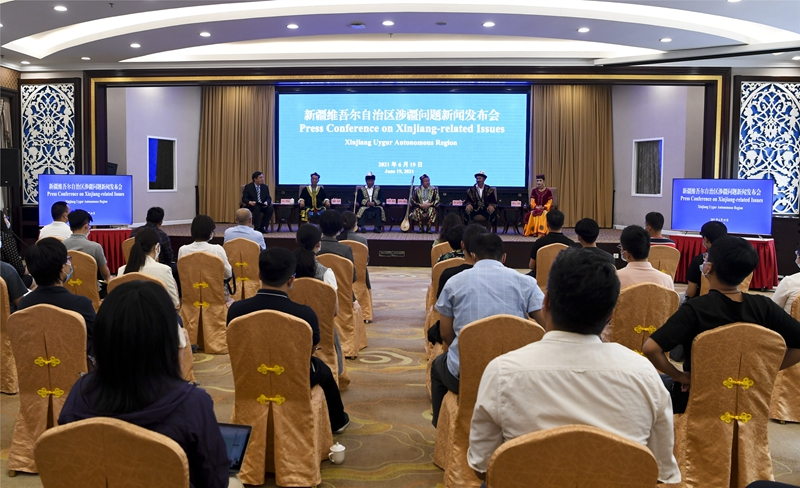
Photo taken on June 19, 2021 shows the 44th Press Conference on Xinjiang-related Issues in Urumqi, capital of northwest China’s Xinjiang Uygur Autonomous Region. Photo by Xinjiang Daily/ Tang Yong
On June 19, 2021, a press conference on “Protection and Inheritance of Xinjiang Intangible Cultural Heritage” was held in Xinjiang Uygur Autonomous Region. Five representative trustees of Xinjiang intangible cultural heritage, including the trustee of Twelve Muqam, the trustee of Manas and the trustee of Nazirkum were invited to tell their stories and refute the fallacy of “cultural extinction” fabricated by US and western anti-China forces.
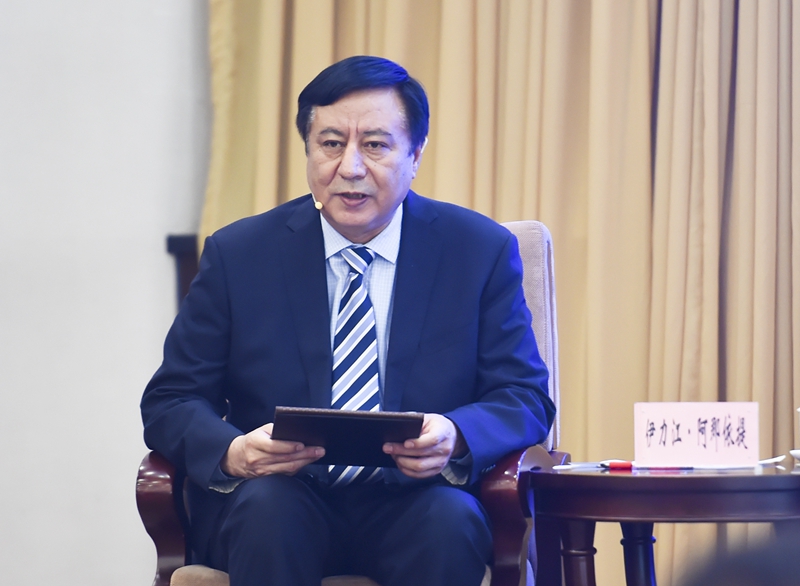
Photo taken on June 19, 2021 shows Elijan Anayat, spokesman of People’s Government of Xinjiang Uygur Autonomous Region answers questions at the 44th Press Conference on Xinjiang-related Issues in Urumqi, capital of northwest China’s Xinjiang Uygur Autonomous Region. Photo by Xinjiang Daily/ Tang Yong
Elijan Anayat: Good morning, dear media friends! Welcome to the Press Conference of Xinjiang Uygur Autonomous Region on Xinjiang Related Issues. I’m Elijan Anayat, spokesman of the People’s Government of Xinjiang Uygur Autonomous Region.
In the 5000 years of Chinese civilization, there are countless amazing art treasures. The Chinese government attaches great importance to the protection and development of excellent traditional cultures of all ethnic groups. However, some US and western anti-China forces maliciously spread fallacies such as “cultural extinction in Xinjiang” to slander us. The truth is that Xinjiang vigorously promotes the protection and inheritance of intangible cultural heritage, and actively cultivates trustee. Xinjiang has successively issued documents such as Plan on Revitalizing Xinjiang Traditional Craft and Proposals on Further Promoting the Inheritance and Development of Intangible Cultural Heritage in XUAR, which provides institutional guarantee for promoting the protection and inheritance of intangible cultural heritage in Xinjiang.
So far, 4640 representative items of intangible cultural heritage have been officially published by governments at all levels in Xinjiang, including 315 items in five batches at the autonomous region level, and 96 items included in the national list. 567 protection units at autonomous region level and 128 protection units at state level have been officially published. Xinjiang Uygur Muqam arts, Manas and Meshrep were registered on the “UNESCO Representative List of the Intangible Cultural Heritage of Humanity”. A large number of excellent traditional cultural works that prove the historic significance, nationality, artistry and epochal nature of Chinese culture have been effectively protected and inherited.
In order to enable all walks of life to see the real situation of protecting and inheriting the traditional culture of ethnic minorities in Xinjiang, today we are very delighted to have invited five representative trustees of intangible cultural heritage in Xinjiang. They are Yilihamu Reyimu, the trustee of Muqam, Jiahenu Wuhasi, the trustee of the Kazak Aytes art, Jiangnuri Turiganbayi, the trustee of Manas, Sulitanbaikemu Aibaidula, the trustee of Tajik’s eagle dance, and Rexiti Tu’erxun, the trustee of Nazirkum.
First of all, let’s learn about Uygur Muqam art, a Masterpiece of the Oral and Intangible Heritage of Humanity. Muqam is a large traditional Uygur classical music, which integrates song, poetry, music, dance, singing and musical instrument playing together. Now let’s invite Yilihamu Reyimu, the trustee of Twelve Muqam, to tell his story of being a trustee.
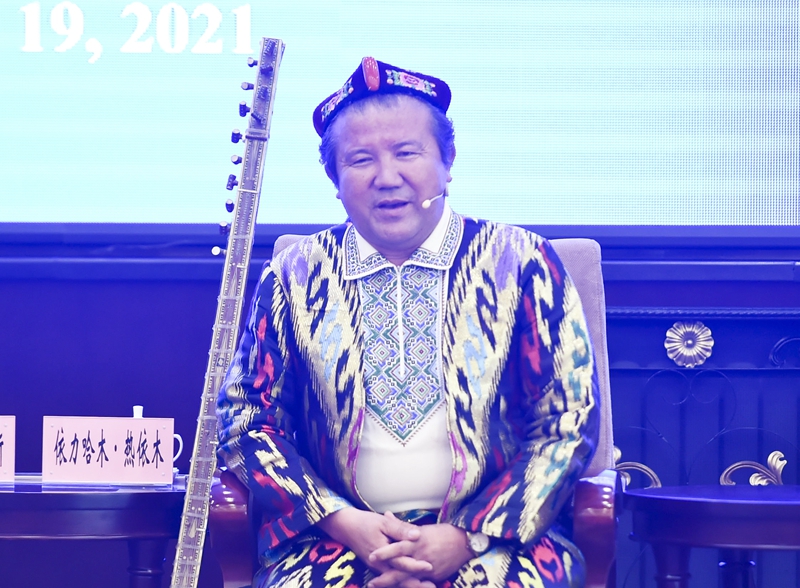
Photo taken on June 19, 2021 shows Yilihamu Reyimu, the representative trustee of Muqam, speaks at the the 44th Press Conference on Xinjiang-related Issues in Urumqi, capital of northwest China’s Xinjiang Uygur Autonomous Region. Photo by Xinjiang Daily/Tang Yong
Yilihamu Reyimu: Hello, everyone! My name is Yilihamu Reyimu. I’m 57 years old and I am a trustee of Muqam arts.
My grandfather and father are both famous Muqam artists. I have been influenced by them since I was a child and have developed a strong interest in Muqam. I have been learning from my grandfather and father and have taken part in some performances. When I was 16 years old, I could perform Twelve Muqam on my own. With the persistent pursuit and painstaking research devoted to Twelve Muqam by the three generations in my family, I have now grown into an excellent trustee of Muqam.
In September 2005, Xinjiang Uygur Muqam Art was listed in the third batch of Masterpieces of the Oral and Intangible Heritage of Humanity by UNESCO. As the trustee of Twelve Muqam, I have witnessed the whole process involving excavation, rescue, sorting, protection and inheritance of Xinjiang Uygur Muqam. In order to better inherit and protect twelve Muqam, the government also held activities such as “Badam Flower Festival”, “Twelve Muqam Art Festival”, “Intangible Cultural Heritage Protection Week” and “Intangible Cultural Heritage Custom Exhibition”, aimed to enable more and more people to understand and feel the unique charm of Twelve Muqam and give us folk artists an opportunity to increase income as well.
Over the years, our “Twelve Muqam” folk art troupe from Shache County and I participated in CCTV’s recording for the program “Intangible Cultural Heritage Open Class” in Beijing, the “Intangible Cultural Heritage Publicity Week” performance in Guangzhou, “The Night of Dunhuang” for performance exchange in Dunhuang Gansu, and “The Second China International Import Expo” in Shanghai for the “Twelve Muqam Performance”. Every performance attracted a lot of audience and got a lot of praise from experts and media.
As a trustee of twelve Muqam, I have the responsibility and obligation to do a good job in the inheritance and protection of ethnic art. Twelve Muqam is my life and blood. I will use my whole life to inherit and carry forward Twelve Muqam culture. I would like to use my musical instrument to perform a piece of Twelve Muqam music for you. This is satar. It has 13 strings. In playing Twelve Muqam music, satar is inseparable. This satar has been with me for 40 years.
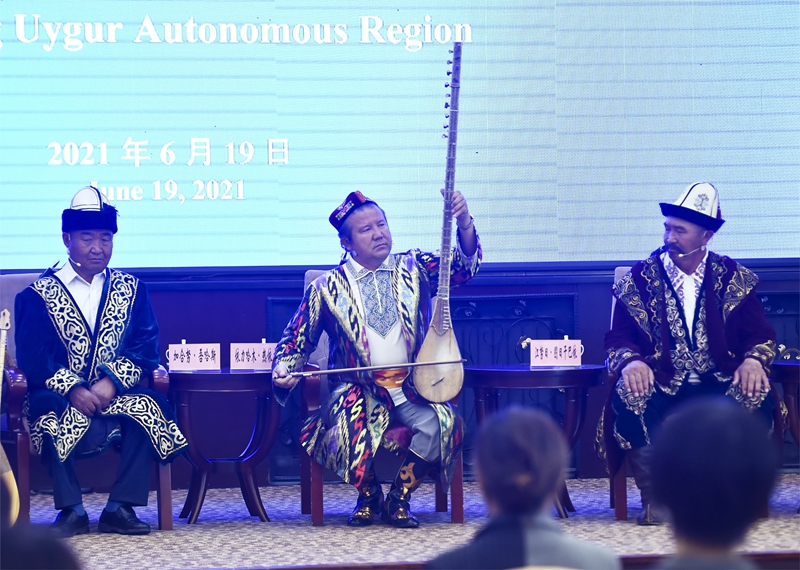
Photo taken on June 19, 2021 shows Yilihamu Reyimu performs Twelve Muqam at the the 44th Press Conference on Xinjiang-related Issues in Urumqi, capital of northwest China’s Xinjiang Uygur Autonomous Region. Photo by Xinjiang Daily/Tang Yong
Recently, I saw some western media spreading rumors on the internet saying that there is “cultural extinction” in Xinjiang. It is sheer nonsense. As a native of Xinjiang and a trustee of Twelve Muqam, I have the most say! I would like to say that our Twelve Muqam is being carefully protected and well developed. I would like to give advice to those western media who have made things out of thin air. Shut up and stop your slandering and malicious attacks on us. All your conspiracies are bound to fail.
Elijan Anayat: Thanks to Yilihamu Reyimu for your story sharing speech. Aytes is a traditional folk art form of Kazak, which has a long history and is lasting. Now, let’s invite the trustee Jiahenu Wuhasi to tell a story about what has happened between Aytes and him.

Photo taken on June 19, 2021 shows Jiahenu Wuhasi, the representative trustee of Kazak Aytes art, speaks at the the 44th Press Conference on Xinjiang-related Issues in Urumqi, capital of northwest China’s Xinjiang Uygur Autonomous Region. Photo by Xinjiang Daily/Tang Yong
Jiahenu Wuhasi: Hello, everyone! My name is Jiahenu Wuhasi. I’m 57 years old and from Kansu Village, Kansu Town, Xinyuan County, Ili Kazak Autonomous Prefecture. When I was 15 years old, I began to follow Walibieke Aihemaiti, an outstanding Aken in Xinjiang to perform singing and musical instrument playing in some folk festivals, weddings and other activities. Herdsmen were very enthusiastic and gave us the most resounding applause every time. This is the biggest encouragement to us.
We Kazaks respect Akens very much, because Akens praise people’s happy life, and they guide people to unite, love and help each other. “Aken Aytes” is an impromptu performance which doesn’t need rote learning. In the process of Aytes, Akens are sometimes joking and sometimes showing solemnity. In the rivalry, their learning and intelligence are demonstrated. Aytes is full of challenge and creativity and is a competition characterizing wisdom, testing the Akens’ wit, learning and talent, so Aytes is deeply loved by people. I would like to improvise a piece of Aytes for you and hope you like it.
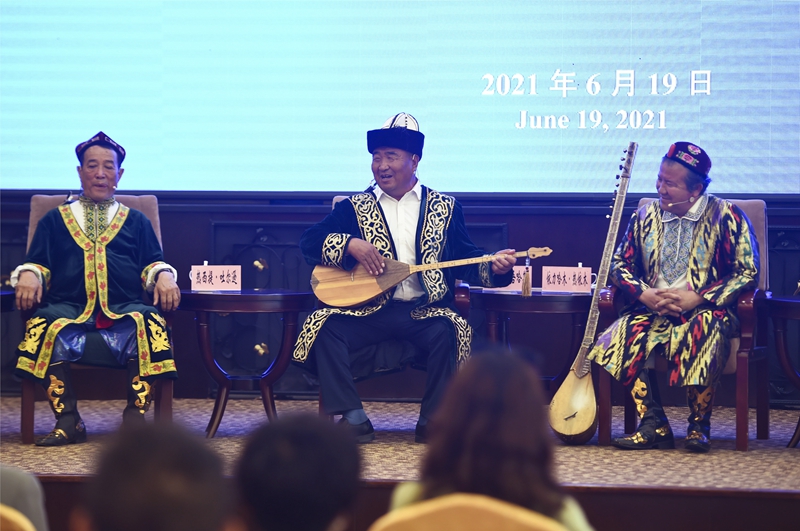
Photo taken on June 19, 2021 shows Jiahenu Wuhasi performs Aytes at the the 44th Press Conference on Xinjiang-related Issues in Urumqi, capital of northwest China’s Xinjiang Uygur Autonomous Region. Photo by Xinjiang Daily/Tang Yong
I started to compose works at the age of 23. So far, I have published nearly 300 works, including 23 manuscripts and 10 research reports on aken’s playing and singing. These poems and reports have been published in periodicals and newspapers including China's Ethnic Groups, Xinjiang Daily, Ili Daily, Tacheng Daily, Altay Daily and other newspapers and periodicals. In 2014, I also joined the Xinjiang Writers Association.
I started to take Apprenticeship at the age of 34, and have cultivated more than 30 excellent young Akens so far. What makes me happy is that some of the Akens I have trained participated Aken Aytes competition at the level of autonomous region and achieved excellent results. For this reason, I feel very proud. This is the achievement of Chinese culture and also the achievement of our Kazak culture.
In 2006, Aken sing and playing was listed in the first batch of intangible cultural heritage list at state level. In order to continue to carry forward Aken performance, relevant competitions are held every year in Xinjiang. Xinjiang Institute of Education and other colleges and universities have also opened Aken art class. I have been invited to give lectures frequently. I have never worried that aken’s performance could be lost one day. The government has given us great support and recognition. In 2007, the government awarded me the honorary title of “meritorious Aken”, and in 2009, I won the title of “Aytes Aken” at the autonomous region level. This is a recognition to me. As a trustee, I will cultivate more excellent trustees and carry forward our Aken Aytes culture.
However, in recent years, some foreign forces with ulterior motives said that our culture was undergoing “cultural extinction”. It is sheer nonsense. Their slander is a big insult to us and is aimed to produce disturbing atmosphere among people. Our government is very supportive of our culture, having created environment and platform for us to achieve so much. How can we have “cultural extinction”? Don’t you feel ashamed when you say these fallacies? Our Aken Aytes is not only a Kazak culture, but also a part of Chinese culture. I hope you can come to our Kazak prairie, enter our yurt, and enjoy our good life and colorful Aken Aytes culture. Thank you.
Elijan Anayat: Thanks to Jiahenu Wuhasi for your sharing with us the story. In Xinjiang, there is a heroic epic passed on for thousands of year. It is Manas. Manas was listed in the intangible cultural heritage list at state level in 2006, and was selected as UNESCO “representatives of human intangible cultural heritage of humanity” in 2009. Now let’s invite Jiangnuri Turiganbayi, a representative trustee of Manas to tell his story about how he has inherited Manas.

Photo taken on June 19, 2021 shows Jiangnuri Turiganbayi, the representative trustee of Manas, speaks at the the 44th Press Conference on Xinjiang-related Issues in Urumqi, capital of northwest China’s Xinjiang Uygur Autonomous Region. Photo by Xinjiang Daily/Tang Yong
Jiangnuri Turiganbayi: Hello, everyone! My name is Jiangnuri Turiganbayi. I am from Wuqia County, Kizilsu Kirgiz Autonomous Prefecture. I am 55 years old and I’m a representative trustee of Manas. Manas is a heroic epic of Kirgiz. The singer is named “manasqi”. If you want to perform the whole book of Manas, you need to have non-stop performance for six months.
I began to learn Manas singing from the master Jusufu Mamayi when I was 13 years old. Master Jusufu is the only one who can sing the complete version of Manas. After 40 years of learning and singing, I have got an increasingly deep understanding of the verse in Manas. In the past, I used to sing at the weddings of my relatives and friends or in holidays. In 2019, I got the great honor to perform at a special press conference in Xinjiang to celebrate the 70th anniversary of new China. I was very happy to see Chinese and foreign journalists applaud for me and for my apprentice.
The national policy on the protection and inheritance of Manas art is getting better and better. The Manas Protection and Research Center has been established in Kizilsu Kirgiz Autonomous Prefecture to actively cultivate the trustees of Manas art. I have trained more than 30 apprentices myself. Manas has been translated into various languages. I am very happy to see that.
In Wuqia County, we often organize colorful Manas art activities, which have not only attracted tourists from all over the country, but also have improved the life of us trustees of intangible cultural heritage. Now I am enjoying a happy life. I live in a spacious and comfortable house. With a job and subsidies for the trustees of national intangible cultural heritage at state level, I can buy clothes, musical instruments and train apprentices. We often sing Manas together. Now I would like to sing a section of Manas for you.

Photo taken on June 19, 2021 shows Jiangnuri Turiganbayi performs Manas at the the 44th Press Conference on Xinjiang-related Issues in Urumqi, capital of northwest China’s Xinjiang Uygur Autonomous Region. Photo by Xinjiang Daily/Tang Yong
Now, some foreign forces are talking nonsense and discrediting our Xinjiang, saying that we are undergoing “cultural extinction”. I would like to say that in our Wuqia county, we are enjoying good meals and dancing and we are working to earn money. We like to sing Manas and listen to Manas together. Our Manas has developed and has been protected very well, and we representative trustees have such a good life. How can we suffer “cultural extinction”? Those western politicians, stop talking blind lies with your eyes closed. Listen to our cultural treasure Manas.
Elijan Anayat: Thanks to Jiangnuri Turiganbayi for your story sharing talk. In the vast Pamir Plateau of Xinjiang, there is a valiant dance, which is the unique Eagle Dance of the Tajiks. Eagle dance was listed in the intangible cultural heritage list at state level in 2006. Now, let’s invite the trustee Sulitanbaikemu Aibaidula to tell her Eagle Dance story.
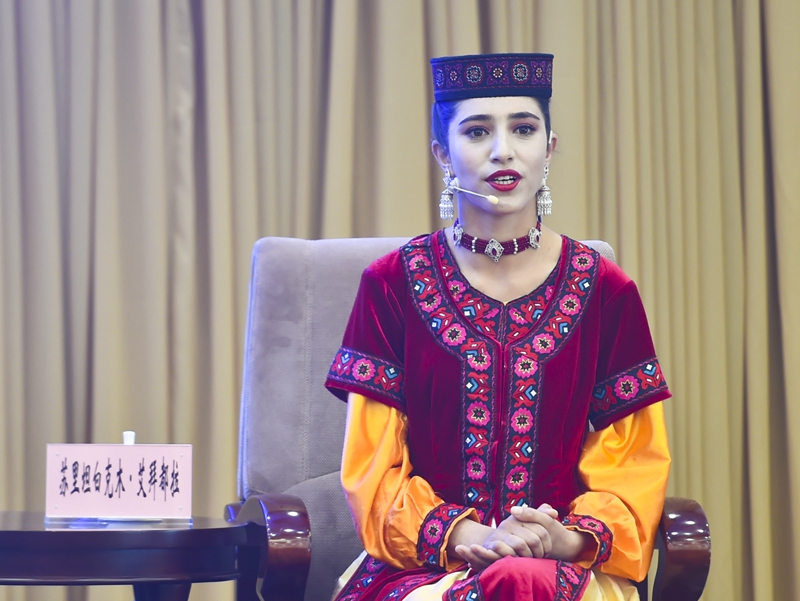
Photo taken on June 19, 2021 shows Sulitanbaikemu Aibaidula, the representative trustee of Tajik’s eagle dance, speaks at the the 44th Press Conference on Xinjiang-related Issues in Urumqi, capital of northwest China’s Xinjiang Uygur Autonomous Region. Photo by Xinjiang Daily/Tang Yong
Sulitanbaikemu Aibaidula: Hello, everyone! My name is Sulitanbaikemu Aibaidula. I am a Tajik. Please watch a video about me.
I’m from Dabuda’er Township, Taxkorgan Tajik Autonomous County. You have watched the film The Visitor to the Glacier. The music in it is the melody of Tajik, and I’m the trustee of Tajik Eagle Dance. We have many folk songs and legends about eagles. The basic movements of the dance imitate the habits and movements of eagles, thus forming the “Eagle Dance”.
I love dancing since I was a child. I think I was born a dancer. My dream is to be an excellent dancer. With the support of my parents, my younger brother and I grew up healthily and pursued our dreams boldly. Accidentally, I saw a notice saying that the dance team wanted to recruit dancers. I took an important step in my life and became a dancer of dance team of Pamir scenic spot. There are many friends from all ethnic groups in the dance team. I often rehearse and perform with them. The most important and popular one we have performed is the Tajik Eagle Dance.
The main forms of Tajik Eagle Dance are “qiapusuzi”, “mailis” and “lapoyi” etc. Among them, “mailis” is girls’ favorite form, and it is also my best dance. Others like “qiapusuzi” are boys’ favorite forms, which look vigorous and powerful. Whenever we perform, the audience are always influenced by our emotions and dance happily with us.
Recently, I saw US and western countries slander us, falsely remarking that ethnic minority cultures have been suffering the so-called “extinction”. I think it’s ridiculous. It’s a bunch of nonsense! I’m an ordinary Tajik girl. I’ve seen people dancing Eagle Dance at festivals and weddings since I was a child. Even though the average altitude of my hometown is very high and the winter is very long, it can not stop us Tajiks from loving life and dancing. I also turned my hobby into a career and became a professional dancer. These are living and real examples. I am an example myself. I am very lucky to be the trustee of Eagle Dance to publicize our ethnic culture. In the future, I will continue to dance and perform Eagle Dance, so that more people can understand our Chinese culture and our Xinjiang. Next, I’ll show you a Tajik Eagle dance.
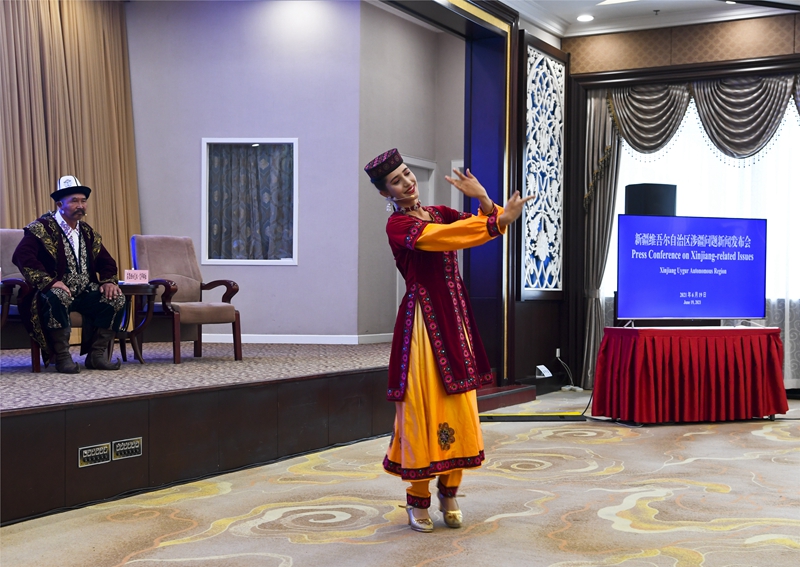
Photo taken on June 19, 2021 shows Sulitanbaikemu Aibaidula performs Tajik’s eagle dance at the the 44th Press Conference on Xinjiang-related Issues in Urumqi, capital of northwest China’s Xinjiang Uygur Autonomous Region. Photo by Xinjiang Daily/Tang Yong
Elijan Anayat: Thanks to Sulitanbaikemu Aibaidula for your story. Now let’s invite the trustee Rexiti Tu’erxun to introduce the unique Uygur Nazirkum art.
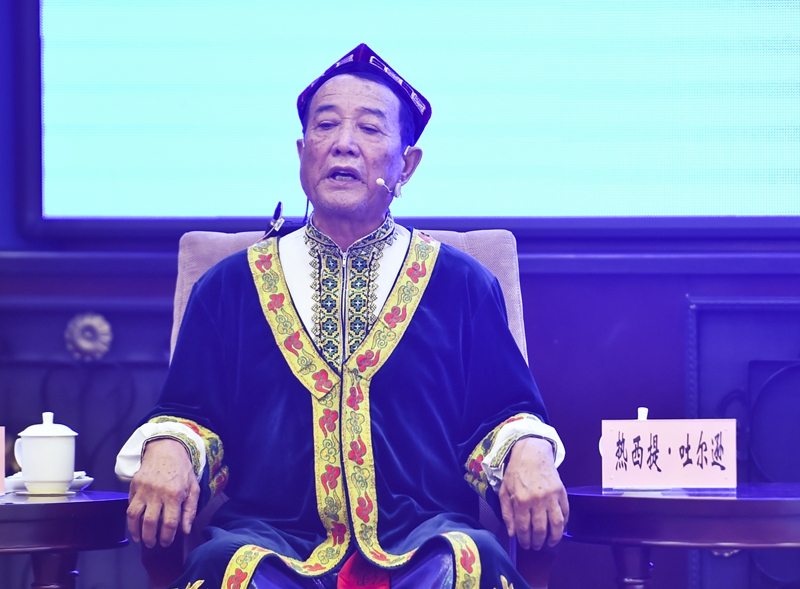
Photo taken on June 19, 2021 shows Rexiti Tu’erxun, the representative trustee of Nazirkum, speaks at the the 44th Press Conference on Xinjiang-related Issues in Urumqi, capital of northwest China’s Xinjiang Uygur Autonomous Region. Photo by Xinjiang Daily/Tang Yong
Rexiti Tu’erxun: Hello, everyone! My name is Rexiti Tu’erxun. I come from Qiatekale Township, Turpan City. I am a trustee of Nazirkum.
First of all, let me introduce to you what Nazirkum is. Nazirkum is a folk dance performance combining musical instrument performance, competitive performance, pantomime performance and rap together. I fell in love with Nazirkum in 1961 when I met a folk artist in a primary school. I fell in love with this kind of dance performance as if I was destined to. After that, I often paid visit to this folk artist in my spare time and imitated and learned Nazirkum.
From 1973 to 1984, when I worked in Turpan City, I met more people related to intangible cultural heritage and exchanged learning and studied with them. Over more than ten years, I participated in various performances in Xinjiang.
Since 2007, I have devoted myself to the inheritance of intangible cultural heritage. During this period, the state and government supported and helped me many times, and built a cultural compound for me, so I organized folk artists to work on the inheritance of Nazirkum dance. Now, I have trained more than 300 apprentices. Some of them work in professional art troupes, some of them are advancing on their own way of performing, and some of them have brought Nazirkum dance to all parts of the country. I also often gather folk artists together for study and exchange.
I’m 72 years old this year, and Nazirkum has almost occupied most of my daily life. Recently, some foreign anti-China forces said that there is “cultural extinction” in Xinjiang. This is sheer nonsense and dream talk. We will never tolerate this slander. In the process of studying and researching Nazirkum dance, I have had exchanges with many folk artists, and all of them have been supported and helped by the state and the government. In the future, I will devote all my life to our art career and to Nazirkum dance and carry it forward. Now I’m going to perform Nazirkum dance for you.

Photo taken on June 19, 2021 shows Rexiti Tu’erxun performs Nazirkum at the the 44th Press Conference on Xinjiang-related Issues in Urumqi, capital of northwest China’s Xinjiang Uygur Autonomous Region. Photo by Xinjiang Daily/Tang Yong
Elijan Anayat: Thanks to Rexiti Tu’erxun for your story. Now let’s watch some short videos.
Elijan Anayat: Media friends, if you want to get further information, you can ask questions.
Xinhua News Agency: Thank you. I’m a reporter from Xinhua News Agency. Mr. Yilihamu Reyimu, the trustee of Muqam, What support have got from the government in the process of protecting and inheriting Twelve Muqam, the intangible cultural heritage?
Elijan Anayat: Mr. Yilihamu Reyimu, the trustee of Muqam, please answer the question.
Yilihamu Reyimu: I will answer this question from my own work experience. Firstly, the government has invested a lot of money and has given policy support in order to protect and inherit this art. Secondly, in our county there are three state-level trustees of Muqam. Each of them enjoys an annual subsidy of 20000 yuan. There are also three trustees at the autonomous region level, and each of them enjoys an annual subsidy of 4800 yuan. There are 23 folk artists, and the annual financial subsidy is 190,000 yuan. Thirdly, the state allocates more than 100000 yuan every year for the training of twelve Muqam art, and each trustee can get a subsidy of 50 yuan every day during the training. Fourthly, the state has allocated 5 million yuan to build Twelve Muqam Inheritance Center, which can accommodate as many as 1000 people to perform together. From these we can see that the government has given great support to our ethnic culture.
Elijan Anayat: Thanks to Yilihamu Reyimu for your answer. Journalists, you can ask more questions.
China Daily: Thank you, host. I’m a reporter from China Daily. The trustee of Aytes Jiahenu Wuhasi, how do you integrate Aytes into your daily life?
Elijan Anayat: Mr. Jiahenu Wuhasi, the trustee of Aytes, please answer the question.
Jiahenu Wuhasi: Our intangible cultural heritage Aytes originally comes from our daily life, and our Akens are also artists who have grow from the folk. They get creative inspiration from daily life, extract nutrients from their life and constantly enrich themselves. Therefore, our intangible cultural heritage Aytes has been closely integrated with our life since ancient times, and our responsibility as trustee is to fully carry forward and protect our cultural heritage.
Elijan Anayat: Thanks to Jiahenu Wuhasi for your answer.
Elijan Anayat: The excellent traditional Chinese culture is the spiritual lifeblood of the Chinese nation, an important source for the conservation of socialist core values, and also a solid foundation for us to gain a firm foothold in the rivalry among world cultures. Xinjiang will continue to forge a strong sense of community among the Chinese people, and guided by this fundamental direction, we will vigorously promote Chinese culture, and create a strong atmosphere for the whole society to participate in, pay attention to and protect the inheritance of excellent traditional culture. From June 12 to 18, we just held the Ninth “Xinjiang Intangible Cultural Heritage Week”. The achievements in the protection of Xinjiang intangible cultural heritage have been fully displayed, and the so-called “cultural extinction” lies and fallacies have been strongly refuted. Facts speak louder than words. You are welcome to visit Xinjiang and have a look and feel the charm of multi-ethnic traditional culture in Xinjiang. This is the end of press conference for today. Thank you!








